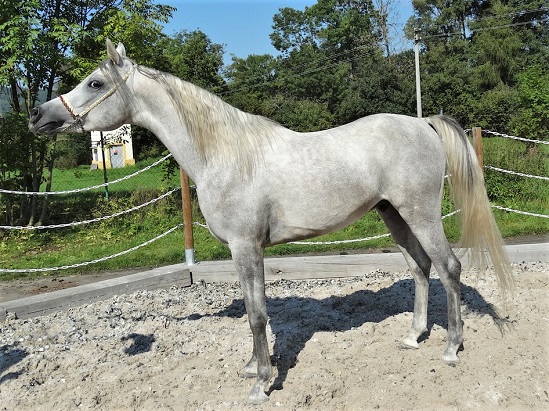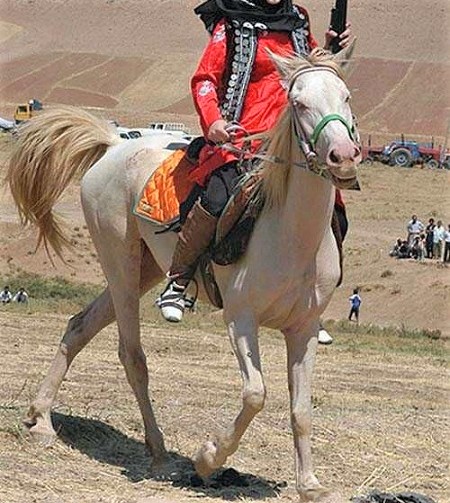The Persian Empire once dominated a large area of the Middle East. The people of Persia had an eye for horse breeding, developing athletic, beautiful, and fiery horse breeds.
During its height, the Persian Empire covered modern-day Iran, Egypt, and Turkey, along with parts of Afghanistan and Pakistan.
The most recognizable Persian horse breeds still around today are the Asil Arabian, Caspian, Turkmen, Kurdish, Tchenarani, Darashouri, and Bakhtiari. These magnificent horse breeds trace back all the way to Persian times.
Here are seven native Persian horse breeds.
1. Asil Arabian

WLen / Shutterstock.com
Asil horses come from a long line of Arabian horses that never left Persia. Traditionally, these horses were bred and kept by local families and tribes.
Asil horses are among some of the purest horses in the world, as they have gone without any crossbreeding of non-Arabian horses. Their bloodlines have long been protected for thousands of years. Breeders even believed that these horses would bring spiritual and material gain to whoever kept them, making them highly-prized possessions.
Asil Arabians, sometimes referred to as Persian Arabians, are intelligent, powerful, and good-tempered. They stand around 14.3-15 hands tall and are mainly gray, bay and chestnut. They have a small straight head that is not too dished, fine legs, a well-arched neck, and a lean, athletic build.
Asil horses excel at endurance, racing, and as show horses in all English and western disciplines.
2. Caspian

The Caspian horse is an ancient small, elegant horse breed originally from Iran that commonly appeared in Persian art. For over 1,000 years, it was believed that the Caspian breed had gone extinct.
Then, in 1965, American Louise Firouz discovered a small number of Caspian horses in mountainous regions south of the Caspian Sea. Upon the rediscovery of these horses, a breeding program began to preserve this special breed.
Included in our list of unique horse breeds, Caspian horses have five unique skeletal differences that separate them from all other breeds.
Caspians are small horses, standing between 10-12.2 hands tall, with an appearance similar to Arabians. They have refined heads, athletic bodies, and well-arched necks. Caspian horses are versatile, excelling in driving, jumping, eventing, and dressage.
3. Turkmen

4.murat / Shutterstock.com
The Turkmen or Turkoman horse originates from the Turkoman desert. They are closely related to the Akhal-Teke horses, which are their modern descendants.
Thanks to their slender build, Turkmen horses have excellent endurance. Many experts believe they have gone extinct in their pure form. However, breeders are working hard to preserve the purest descendants of these noble horses.
Turkmen horses stand around 15-16 hands tall. They have a unique metallic sheen to their coat and are generally gray, bay, chestnut, or black. With an athletic, lean build, they excel at racing and endurance riding.
4. Kurdish

Credit: kurdish-horse.ir
The Persian Kurdish or Kurd horse originally comes from modern-day western Iran. For many millennia they have been an important aspect of life to the Kurdish people.
Though they have a long history, there is no formal established studbook or breed registry. However, those dedicated to the Kurdish horse are working on setting a breed standard.
Kurdish horses are of medium height, with a compact, muscular body and a strong, upright neck. They are powerful, athletic horses suitable for or polo, exhibition dressage, and pleasure riding.
5. Tchenarani

The Tchenarani or Chenaran horse dates back over 2,000 years. They are a rare breed, with only a few pure horses remaining in Iran.
Tchenarani horses were developed by crossing Persian Arabians and Turkoman horses. Once mighty military horses, locals now use them for racing and pleasure riding. They stand around 15 hands tall with an athletic build that showcases their Arabian heritage.
6. Darashouri

The Darashouri originates from the central and southern regions of the Zagros mountain range in modern-day Iran. The breed received its name from the Dareshuri tribe of the Qashqai tribal confederation.
Their true origins are unknown, however, experts believe they come from Persian Arabian bloodlines. Though they were once a popular breed, their numbers are now critical.
Darashouri horses stand around 15-16 hands tall and are typically chestnut, gray, black, and bay. They have a muscular body, arched neck, and wide chest. Intelligent and friendly, Darashouris make reliable riding mounts.
7. Bakhtiari

The Bakhtiari is a variant of the Plateau Persian horse of Iran. They have the same heritage and also conformation as these ancient Persian horses.
These unique horses got their name from the Bakhtiari tribesmen of the Khuzestan Province. The Bakhtiari traces back to the Hamdani, Khuhilan and Nesmam Arabian strains. However, they are taller and lankier than their Arabian ancestors.
They have an elegant, graceful build, but do not have as defined features other strains of Arabian horses have. Bakhtiari horses stand around 15 hands tall and are a popular choice for pleasure riding and also racing.
Source: horseyhooves.com








